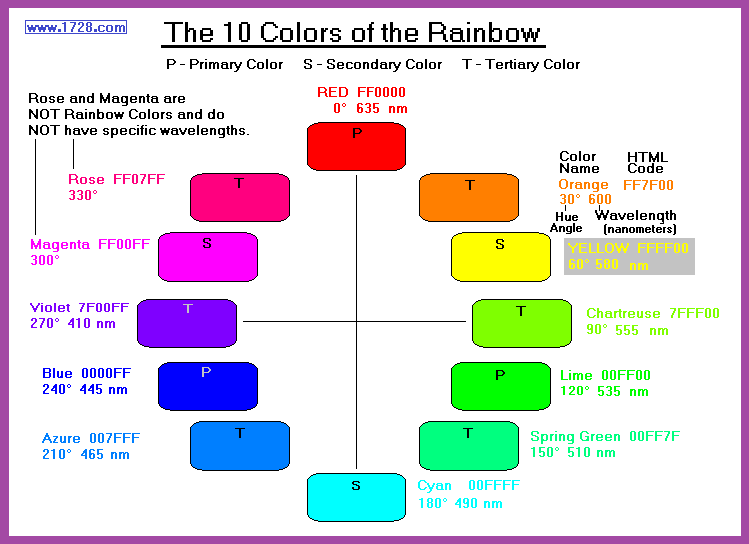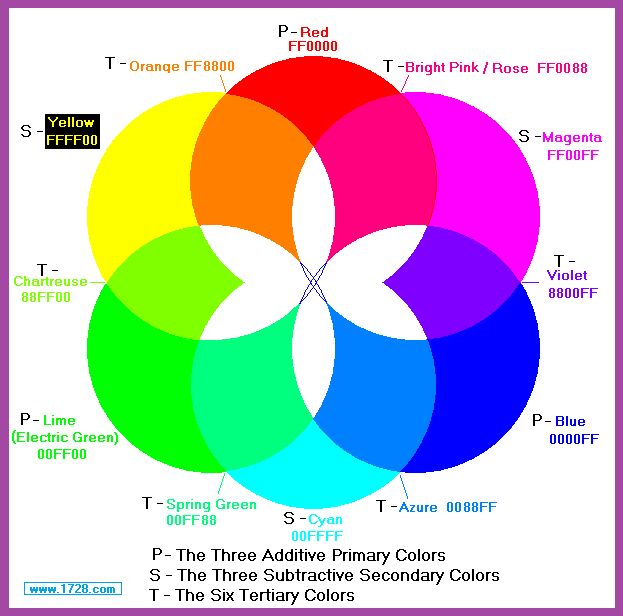|
As we learned in part one, each of the HTML colors is defined by a 6 digit hexadecimal number. (For example, this command <font color=0000FF> will change the font color to blue.)
Website colors (or HTML colors) are classified by the RGB color model, in which all colors are based upon the different amounts of red, green and blue they contain. (Look at the table below, and you'll see that as the HEX codes change, the amounts of Red, Green and Blue also change.)
Notice that for any particular color change, only one group of colors changes.
In order to make it easier to see, the numbers that are changing have been placed in italics.
The numbers in the red, green and blue columns are in decimal and hexadecimal notation.
| From | To | Wavelength (nm) | RED |
GREEN | BLUE |
Red
FF0000 | Orange
FF7F00 | 635 to 600 |
255
FF |
0 to 127
00 to 7F |
0
00 |
Orange
FF7F00 | Yellow
FFFF00 | 600 to 580 |
255
FF |
127 to 255
7F to FF |
0
00 |
Yellow
FFFF00 | Chartreuse
7FFF00 | 580 to 555 |
255 to 127
FF to 7F |
255
FF |
0
00 |
Chartreuse
7FFF00 | Lime
00FF00 | 555 to 535 |
127 to 0
7F to 00 |
255
FF |
0
00 |
Lime
00FF00 | Spring Green
00FF7F | 535 to 510 |
0
00 |
255
FF |
0 to 127
00 to 7F |
Spring Green
00FF7F | Cyan
00FFFF | 510 to 490 |
0
00 |
255
FF |
127 to 255
7F to FF |
Cyan
00FFFF | Azure
007FFF | 490 to 465 |
0
00 |
255 to 127
FF to 7F |
255
FF |
Azure
007FFF | Blue
0000FF | 465 to 445 |
0
00 |
127 to 0
FF to 00 |
255
FF |
Blue
0000FF | Violet
7F00FF | 445 to 410 |
0 to 127
00 to FF |
0
00 |
255
FF |
When going from red (FF0000) to orange (FF7F00), we see the amounts of red and blue remain unchanged, and the amount of green increases from 0 to 127 (decimal) (or 00 to 7F (hexadecimal).
Also notice that the wavelength decreases from 635 to 605 nanometers.
The 10 colors in the table above are usually presented in the form of a "color wheel". (see the graphic below).

Colors of the Rainbow
When it was thought that the 3 primary colors were blue, red and yellow and the 3 secondary colors were orange, green and violet, this yielded all the colors of the rainbow.
(Indigo is no longer considered a rainbow color and it probably was included by Isaac Newton (who had some occult beliefs) thought that since there are 7 musical notes,
7 days of the week and 7 astronomical objects (Sun, Moon, Mercury, Venus, Mars, Jupiter, Saturn), then there must be 7 colors.) If Isaac Newton had not included indigo, the rainbow colors would look like this.

The primary colors are now considered to be red, green (actually lime) and blue with the secondary colors being yellow, magenta and cyan.
We only get one of the classical rainbow colors (yellow) with these secondary colors and so we have to include two tertiary colors (orange and violet)
to get all 6 classical rainbow colors.

In order to display a spectrum of colors, showing a smooth transition from red to blue we should show all primary, seconday and tertiary colors.
(See graphic below.)

Here are the same colors presented horizontally.
the symbol "λ" means "wavelength"
|
| Color |
HTML |
λ
Wavelength |
* * * * * * * * * * * * * * * * * * * * * * * * * * * * * * * * * * * |
RED
|
FF0000 |
635 nm |
|
ORANGE
|
FF7F00 |
600 nm |
|
YELLOW
|
FFFF00 |
580 nm |
|
CHARTREUSE
|
7FFF00 |
555 nm |
|
LIME
|
00FF00 |
535 nm |
|
Spring Grn
|
00FF7F |
510 nm |
|
CYAN
|
00FFFF |
490 nm |
|
AZURE
|
007FFF |
465 nm |
|
BLUE
|
0000FF |
445 nm |
|
VIOLET
|
7F00FF |
410 nm |
|
To conclude this article, we should discuss the physics of colors. Just like radio waves, microwaves, x-rays and cosmic rays, colors consist of electromagnetic waves. It would be wise for you to click on that link to see discussions, graphics and formulas concerning electromagnetic waves. That page also contains a handy calculator that will accept nanometers for input and you can calculate color frequencies and photon energy.
|
Copyright © 2000 1728 Software Systems
Return To Home Page
|



